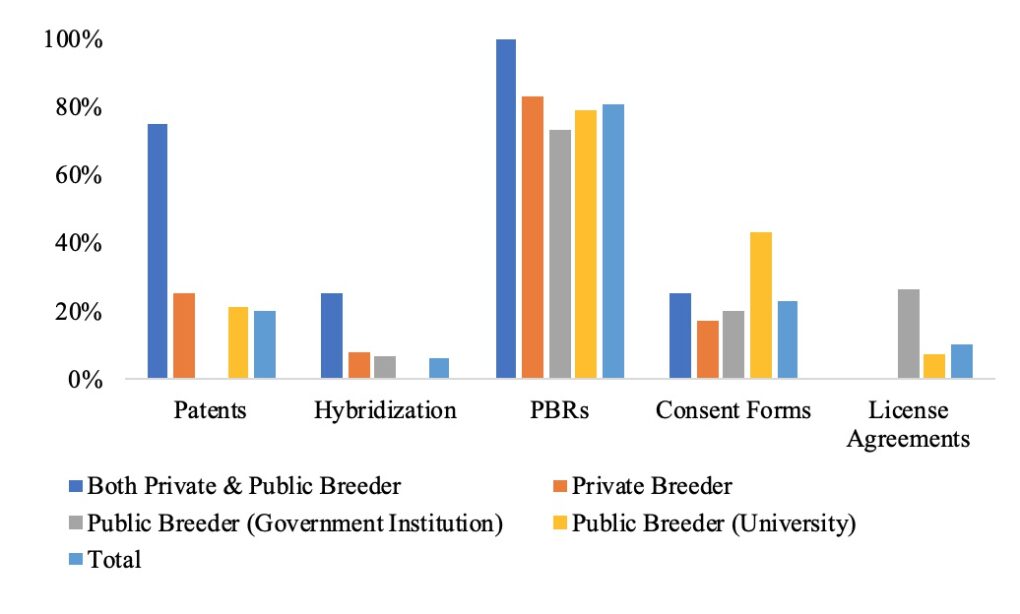Plant breeders’ rights (PBRs) are a form of intellectual property (IP) protection that provide plant breeders protection to newly developed crop, fruit, and vegetable varieties. Canada passed the Plant Breeders’ Rights Act (PBRA) and became part of the Union for the Protection of New Plant Varieties (UPOV), the international regulating body for PBRs, in 1991. In 2015, Canada updated the PBRA, becoming compliant with UPOV-91, the most recent version of the UPOV convention. This update provides further protection for plant breeders including allowing for sales of new plant varieties within Canada for up to one year before filing a PBR application, an extension of the duration of protection for new varieties, and extension of a breeder’s exclusive rights over a newly developed variety.
The key objective of updating Canada’s PBRA was to encourage investment in plant breeding. Plant breeding investments are important to the Canadian agriculture sector, as although the quality of Canadian R&D is high, Canada is less efficient at converting innovative ideas into commercialized solutions. According to the Global Innovation Index, Canada ranks 61st in terms of innovation efficiency. In order to gauge whether updating Canada’s PBRA incentivized additional investments into plant breeding programs, we surveyed 450 public and private Canadian plant breeders (52 fully answered our survey), on whether and how the update has affected their breeding programs.
Survey Results
Prior to determining how plant breeders view the changes to Canada’s PBRA, we asked what types of IP protection are commonly used among breeders. Just over 80% of respondents indicated they use PBRs for IP protection, 25% use consent forms, 21% use patents, 8% use license agreements, and 6% use hybridization. Responses were similar between private and public breeders; however, only private breeders indicated making use of patents, and license agreements were only used by public breeders (Figure 1).

To determine how important IP protection is to breeders, participants were asked if they were confident their new varieties are distinct enough to enforce PBRs in court. The majority of respondents (69%) answered yes, 7% answered no, and 24% were unsure. As a follow-up, participants were asked how much of their total annual breeding program costs are spent enforcing PBRs. Seventy-nine percent answered the amount spent is less than 1% of total annual costs, with 9% indicating that 5% of costs are spent on enforcement, and 3% indicating that 10% or more is spent. Private breeders in this sample indicated they spend slightly more on enforcement costs than public breeders.
Participants were asked some specific questions about Canada’s PBRA updates. The majority (88%) of respondents indicated that the extended duration of PBR protection was appropriate, and 57% indicated that they plan to take advantage of the opportunity to sell newly developed varieties in Canada for a year before filing a PBR application. Public breeders from government institutions were less likely to believe that the duration of protection was appropriate when compared to private breeders and breeders from universities, and fewer than half of government breeders (38%) plan to sell varieties in Canada prior to filing a PBR application.
Participants were also asked to what extent they agreed or disagreed with some specific PBRA amendments. Sixty-four percent of participants agreed with the decision to allow applicants to enforce their PBRs while applications are pending, 63% agreed with allowing breeders to sell newly developed varieties in Canada for a year before filing a PBR application, and 59% agreed with the extension to breeders’ exclusive rights over new varieties (Figure 2).

Overall, 62% of participants responded that the current PBR system in Canada provides sufficient IP protection, while 24% answered that the protection is only partially sufficient, and 9% believe it is not sufficient (Figure 3). Public breeders were more likely than private breeders to believe that the current level of protection is sufficient. When asked if the current PBR system needs further changes to strengthen it, 63% answered no and the remaining 37% answered yes (Figure 3). Public breeders were also less likely than private breeders to indicate that the system needs further improvements.

Finally, participants were asked if the updates increased their incentive to invest in breeding programs. Despite increased investment being the key objective of the 2015 amendments, only 36% of respondents indicated that their incentive to invest increased. Distinctions were seen between public and private breeders, as well as between different types of program funding (Table 1). Private breeders, and those who work in both public and private institutions, indicated an increased incentive to invest compared to public breeders. Those who work in government-funded research programs indicated being less incentivized to invest than those whose programs were funded by producer check-offs or royalty collections.
| Type of Program | Amendments Increase Incentive to Invest | Amendments Do Not Increase Incentive to Invest |
| Both Public & Private | 67% | 33% |
| Private | 44% | 56% |
| Public (Government) | 18% | 82% |
| Public (University) | 33% | 67% |
| Type of Funding | ||
| Government Research Grants | 31% | 69% |
| Producer Check-offs | 50% | 50% |
| Royalty Collection | 43% | 57% |
Table 1: Effect of Program and Funding Type on Incentive to Invest
Implications
Survey results show that Canadian plant breeders are relatively content with the current PBR system and agree with the amendments, yet are not strongly incentivized to increase breeding program investments. In one sense, this result suggests that increased investment may not be a top priority for breeders and that additional investments won’t be made, regardless of IP protection options. Conversely, the results indicate that other elements of plant breeding systems already incentivize sufficient investment, and tighter IP protection is not required.
Distinctions between public and private breeder responses indicate that public breeders and breeders in government-funded programs might be less concerned with, and incentivized by, strong IP protection. Private breeders, or those whose programs are funded by sources outside government, might rely more on strong IP protection to ensure that returns from newly developed varieties are adequate to sustain future R&D.
Though the results indicate that breeders are relatively satisfied with the current IP protection, further research to determine how to increase investment into plant breeding would be beneficial. Determining the optimal balance between public and private breeding, and potential IP system amendments that could help to achieve this balance. It would also help to strengthen Canada’s innovation pipeline and ensure that a steady stream of innovative plant varieties are made available to Canadian farmers for years to come.
To check out the full article titled “Canadian Plant Breeder Opinions Regarding Changes to Plant Breeders’ Rights”, click here.

Sutherland, C., Macall, D., and Smyth, S. J. Canadian plant breeder opinions regarding changes to plant breeders’ rights. Journal of Plant Breeding and Crop Science, 13(2), 46-57. https://doi.org/10.5897/JPBCS2020.0936

